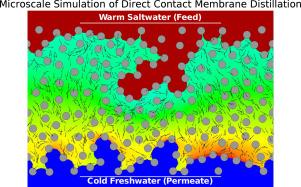Microscale simulation of water desalination in Direct Contact Membrane Distillation
IF 5.8
2区 工程技术
Q1 ENGINEERING, MECHANICAL
International Journal of Heat and Mass Transfer
Pub Date : 2025-09-05
DOI:10.1016/j.ijheatmasstransfer.2025.127751
引用次数: 0
Abstract
Direct Contact Membrane Distillation (DCMD) is a promising desalination technique that can utilize low-grade energy to desalinate water. This study presents a microscale approach to simulate evaporation and condensation inside hydrophobic fibrous membranes. The novelty of the proposed method is that it incorporates the microstructure of the membranes in the calculations and can potentially be used for optimizing membrane’s microstructure. In particular, the model predicts how feed or permeate pressures and temperatures impact the rate of freshwater production. The simulations were conducted in computational domains that mimic the internal geometry of fibrous DCMD membranes in 2-D. The air–water interfaces (AWIs) over the feed and permeate sides of the membrane were simulated using an in-house Pore Morphology Method (PMM) MATLAB code. The resulting wetting and non-wetting phases were then exported to ANSYS using a cell-marking method. The Schrage phase change model was coupled with the ANSYS’s volume of fluid (VOF) solver to simulate water evaporation at the feed AWI and condensation at the permeate AWI. The simulations revealed that increasing the feed or permeate pressure can, to some extent, improve the rate of freshwater production by bringing the feed and permeate AWIs closer to one another and by increasing their surface areas. It was also observed that increasing the feed and permeate temperatures, while keeping their temperature difference constant, can enhance the freshwater production rate significantly.

直接接触膜蒸馏海水淡化的微观模拟
直接接触膜蒸馏(DCMD)是一种利用低品位能源进行海水淡化的技术。本研究提出了一种微尺度的方法来模拟疏水纤维膜内部的蒸发和冷凝。所提出的方法的新颖之处在于它将膜的微观结构纳入计算,并且可以潜在地用于优化膜的微观结构。特别是,该模型预测了进水或渗透压力和温度如何影响淡水产量。模拟是在模拟二维纤维dmd膜内部几何形状的计算域中进行的。利用自制的孔隙形态学方法(PMM) MATLAB代码对膜进料侧和渗透侧的空气-水界面(AWIs)进行了模拟。然后使用细胞标记方法将所得的润湿相和非润湿相导出到ANSYS中。将Schrage相变模型与ANSYS的流体体积(VOF)求解器相结合,模拟进料AWI处的水分蒸发和渗透AWI处的冷凝。模拟结果表明,增加进料压力或渗透压力可以在一定程度上提高淡水产量,使进料和渗透AWIs相互靠近,并增加其表面积。提高进料温度和渗透温度,在保持其温差不变的情况下,可显著提高淡水产量。
本文章由计算机程序翻译,如有差异,请以英文原文为准。
求助全文
约1分钟内获得全文
求助全文
来源期刊
CiteScore
10.30
自引率
13.50%
发文量
1319
审稿时长
41 days
期刊介绍:
International Journal of Heat and Mass Transfer is the vehicle for the exchange of basic ideas in heat and mass transfer between research workers and engineers throughout the world. It focuses on both analytical and experimental research, with an emphasis on contributions which increase the basic understanding of transfer processes and their application to engineering problems.
Topics include:
-New methods of measuring and/or correlating transport-property data
-Energy engineering
-Environmental applications of heat and/or mass transfer

 求助内容:
求助内容: 应助结果提醒方式:
应助结果提醒方式:


